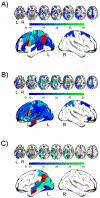Indirect White Matter Pathways Are Associated With Treated Naming Improvement in Aphasia
- PMID: 33719732
- PMCID: PMC8068606
- DOI: 10.1177/1545968321999052
Indirect White Matter Pathways Are Associated With Treated Naming Improvement in Aphasia
Abstract
Background: White matter disconnection of language-specific brain regions associates with worse aphasia recovery. Despite a loss of direct connections, many stroke survivors may maintain indirect connections between brain regions.
Objective: To determine (1) whether preserved direct connections between language-specific brain regions relate to better poststroke naming treatment outcomes compared to no direct connections and (2) whether for individuals with a loss of direct connections, preserved indirect connections are associated with better treatment outcomes compared to individuals with no connections.
Methods: We computed structural whole-brain connectomes from 69 individuals with chronic left-hemisphere stroke and aphasia who completed a 3-week-long language treatment that was supplemented by either anodal transcranial direct current stimulation (A-tDCS) or sham stimulation (S-tDCS). We determined differences in naming improvement between individuals with direct, indirect, and no connections using 1-way analyses of covariance and multivariable linear regressions.
Results: Independently of tDCS modality, direct or indirect connections between the inferior frontal gyrus pars opercularis and angular gyrus were both associated with a greater increase in correct naming compared to no connections (P = .027 and P = .039, respectively). Participants with direct connections between the inferior frontal gyrus pars opercularis and middle temporal gyrus who received S-tDCS and participants with indirect connections who received A-tDCS significantly improved in naming accuracy.
Conclusions: Poststroke preservation of indirect white matter connections is associated with better treated naming improvement in aphasia even when direct connections are damaged. This mechanistic information can be used to stratify and predict treated naming recovery in individuals with aphasia.
Keywords: aphasia; brain connectomics; magnetic resonance imaging; rehabilitation; stroke; white matter.
Figures



Similar articles
-
White Matter Hyperintensities as a Predictor of Aphasia Recovery.Arch Phys Med Rehabil. 2024 Jun;105(6):1089-1098. doi: 10.1016/j.apmr.2024.01.008. Epub 2024 Jan 26. Arch Phys Med Rehabil. 2024. PMID: 38281579 Free PMC article. Clinical Trial.
-
Microstructural properties in subacute aphasia: concurrent and prospective relationships underpinning recovery.Brain Struct Funct. 2024 Dec;229(9):2207-2217. doi: 10.1007/s00429-024-02826-z. Epub 2024 Jul 6. Brain Struct Funct. 2024. PMID: 38969934 Clinical Trial.
-
White Matter Integrity Predicts Electrical Stimulation (tDCS) and Language Therapy Effects in Primary Progressive Aphasia.Neurorehabil Neural Repair. 2021 Jan;35(1):44-57. doi: 10.1177/1545968320971741. Neurorehabil Neural Repair. 2021. PMID: 33317422 Free PMC article. Clinical Trial.
-
Imaging effects related to language improvements by rTMS.Restor Neurol Neurosci. 2016 Apr 11;34(4):531-6. doi: 10.3233/RNN-150631. Restor Neurol Neurosci. 2016. PMID: 27080074 Review.
-
The role of language-related functional brain regions and white matter tracts in network plasticity of post-stroke aphasia.J Neurol. 2024 Jun;271(6):3095-3115. doi: 10.1007/s00415-024-12358-5. Epub 2024 Apr 12. J Neurol. 2024. PMID: 38607432 Review.
Cited by
-
Dynamic network properties of the superior temporal gyrus mediate the impact of brain age gap on chronic aphasia severity.Commun Biol. 2023 Jul 14;6(1):727. doi: 10.1038/s42003-023-05119-z. Commun Biol. 2023. PMID: 37452209 Free PMC article.
-
Behavioural and neural structure of fluent speech production deficits in aphasia.Brain Commun. 2022 Dec 14;5(1):fcac327. doi: 10.1093/braincomms/fcac327. eCollection 2023. Brain Commun. 2022. PMID: 36601623 Free PMC article.
-
Simultaneous Normalization and Compensatory Changes in Right Hemisphere Connectivity during Aphasia Therapy.Brain Sci. 2021 Oct 8;11(10):1330. doi: 10.3390/brainsci11101330. Brain Sci. 2021. PMID: 34679395 Free PMC article.
-
Cerebellar Atrophy and Language Processing in Chronic Left-Hemisphere Stroke.Neurobiol Lang (Camb). 2024 Aug 15;5(3):722-735. doi: 10.1162/nol_a_00120. eCollection 2024. Neurobiol Lang (Camb). 2024. PMID: 39175791 Free PMC article.
-
The elusive metric of lesion load.Brain Struct Funct. 2023 May;228(3-4):703-716. doi: 10.1007/s00429-023-02630-1. Epub 2023 Mar 22. Brain Struct Funct. 2023. PMID: 36947181 Review.
References
-
- Dragoy O, Akinina Y, Dronkers N. Toward a functional neuroanatomy of semantic aphasia: A history and ten new cases. Cortex. 2017;97:164–182. - PubMed
Publication types
MeSH terms
Grants and funding
LinkOut - more resources
Full Text Sources
Other Literature Sources
Medical
Miscellaneous

